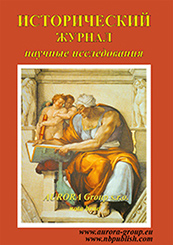History of science and technology
Reference:
Timofeeva, R.A., Chumak, R.N. (2025). Projects of automatic weapons designed by B.E. Sosinsky in Russia in the early 20th century. History magazine - researches, 3, 1Ц10. https://doi.org/10.7256/2454-0609.2025.3.74258
Abstract:
Annotation The subject of study in this article is the period at the beginning of the development of manual automatic weapons in Russia (the turn of the 19thЦ20th centuries). The overall supervision of such works on new weapons was carried out by the Main Artillery Administration (GAU), albeit in a rather general manner, which meant that the level of sophistication of the created models depended on the talent of the inventor. This article analyzes a project that demonstrates a high degree of originality and expressiveness of engineering thought, as well as a considerable potential of domestic inventor-weapons designers. The focus is on the projects of a modified automatic rifle and a machine rifle developed by engineer B.E. Sosinski. This project was considered by the Russian military authorities in the 1900s. It is an undeniable fact that B.E. Sosinski was a skilled and talented engineer who had a deep understanding of and passion for weaponry and possessed significant potential as a weapon designer. However, these traits of his personality were not adequately utilized due to the peculiarities of the weaponry era in Russia. The following research methods were used in this material: historical-scientific analysis of specialized research literature, comparative-historical method, and processing of archival data. In conclusion, it is necessary to characterize Sosinski's machine gun project from the perspective of contemporary knowledge about automatic small arms. Despite the existing shortcomings, as of the date of submission (1906), it was one of the most thought-out and adequately looking proposals. In terms of the quality of technical solutions incorporated into the project, it surpassed by two orders of magnitude the primitive automatic weapon projects being developed at the same time by other Russian inventor-weapons designers. This consideration allows us to put forward the thesis that at the beginning of the 20th century, there were talented inventors in Russia with significant creative potential who, with proper organization of the design process and refinement of weaponry, were capable of creating modern samples.
Keywords:
light machine gun, machine gun, GAU, Main Artillery Directorate, experimental weapons, weapons design, automatic weapons, automatic rifle, three-line rifle, Bronislav Sosinsky
Beliefs, religions, churches
Reference:
Kuldo, M. (2025). All-Russian Congresses of Old Believers of the Belokrinitskaya Hierarchy and the Resettlement of Lipovans to the Russian Far East in the Early 20th Century. History magazine - researches, 3, 11Ц29. https://doi.org/10.7256/2454-0609.2025.3.73822
Abstract:
The article is devoted to a little-studied problem Ц the resettlement of Austrian and Romanian Old Believers-Lipovans to the Russian Far East at the beginning of the 20th century. The work evaluates the significance of the All-Russian Congresses of Old Believers of the Belokrinitskaya Hierarchy and their Council in this process. The role of the immediate leaders of this structure, D. V. Sirotkin and P. P. Ryabushinsky, as active supporters of the idea of returning "foreigners" to the homeland of their ancestors is analyzed. Particular attention is paid to the study of the arguments of both supporters and opponents of the repatriation of Lipovans and their "settlement" in the Amur region. The idea of an organized resettlement of Old Believers to the Far East Ц to Chinese Manchuria Ц to the line of the Chinese Eastern Railway (CER) that was then under construction was first put forward by Finance Minister S. Yu. Witte. In 1900, the dignitary reported this to the delegation of the First Old Believer Congress that arrived in Yalta. After some time, the Yalta proposal became known to the Austrian Lipovans. The local Old Believers, who were experiencing land shortages and other difficulties, had high hopes for the Russian minister's project and expressed a desire to definitely go to Northern China as colonists, but the Russo-Japanese War of 1904-1905 prevented the implementation of this plan. The implementation of another resettlement project (this time to the Russian Amur region) became possible after the revolutionary upheavals of 1905-1907, when the Old Believers received certain civil rights. The liberalization of religious policy in Russia against the backdrop of the deteriorating socio-economic situation in the countries of residence contributed to the return of foreign Old Believers to their historical homeland. Lipovans and Nekrasovites living in Austria, Bulgaria, Romania and Turkey began to submit petitions for Russian citizenship, petitioning for resettlement in the Amur region. The tsarist government, interested in the rapid settlement and economic development of its Far Eastern outskirts, appreciated this desire. The role of the link between the Lipovan communities and the Russian authorities belonged to the Council of Congresses, whose members cared about satisfying not only the spiritual but also the material needs of their co-religionists. By and large, it was thanks to the mediating aspirations of the Council that the resettlement of the "foreigners" became possible, while the "Austrians" and "Romanians" received some benefits.
Keywords:
D. M. Smirnov, P. P. Ryabushinsky, D. V. Sirotkin, Amur region, Russian Far East, Bukovina, resettlement, All-Russian Congresses of Old Believers, Lipovans, Foreign Old Believers
 This work is licensed under a Creative Commons Attribution-NonCommercial 4.0 International License.
This work is licensed under a Creative Commons Attribution-NonCommercial 4.0 International License.










 © 1998 Ц 2025 Nota Bene. Publishing Technologies. NB-Media Ltd.
© 1998 Ц 2025 Nota Bene. Publishing Technologies. NB-Media Ltd.




